What does blight look like on potatoes? If you are growing potatoes, you might have encountered this common fungal disease that could ruin your harvest. It comes in two forms: early and late blight, and they affect the plants differently.
Read on to get insight into the fungal disorder and how to spot it. Also, learn the 7 tips to prevent this problem. Let’s get started!
Contents
Potato Blight Explained!
Potato blight is a devastating plant disease caused by the pathogen Phytophthora infestans. This disease affects the potatoes but can also impact other nightshade family members, such as tomatoes.
You can spot this fungus attack by rotting on the foliage and tuber (fruit) of the plant. Here is a rundown of quick facts about potato blight:
- Common name: Potato Blight.
- Scientific name: Phytophthora infestans.
- Affected Crops: Potato crops and other members of this family like tomatoes, petunias, and solanums.
- Symptoms of attack: Dark, water-soaked lesions on leaves and tubers, rapid tuber decay with brown spots and rot.
- Caused by: Water mold fungi or oomycete, also known as Phytophthora infestans.
- Timing to grow: Typically occurs during periods of warm and wet weather, commonly in early summer onwards
- Spread: A rapid spread; fungal spores are easily carried by wind, rain, or irrigation water.
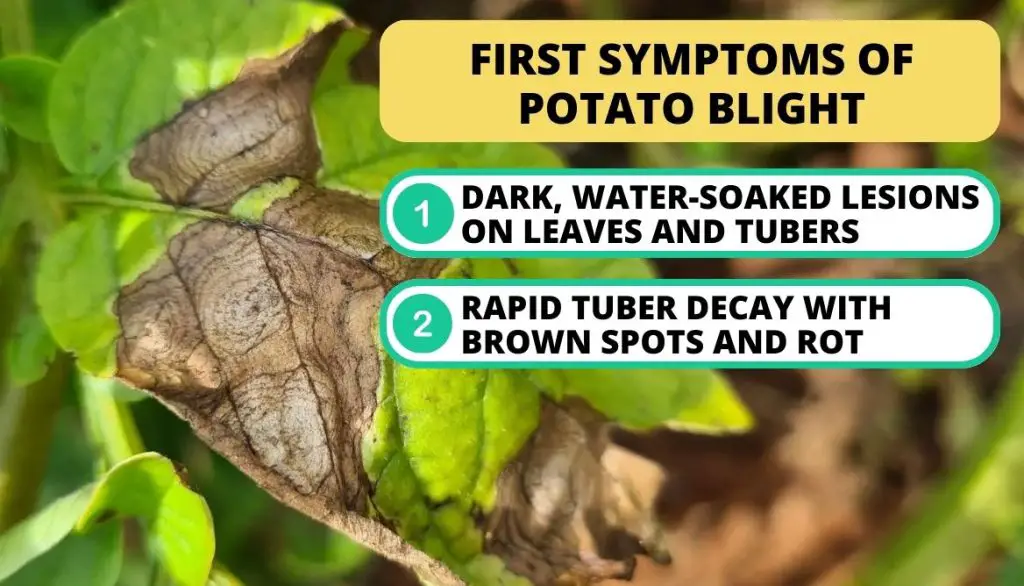
What Does Blight Look Like on Potatoes? Find Out
When it comes to identifying blight on potatoes, there are distinct visual cues to watch out for. Let’s learn about them:
External Appearance
The following changes can be observed on the outside of the plant:
- The appearance of blight on the potato plant is characterized by green to darker patches. Plus, there will be water-soaked lesions on the outside.
- These lesions often have an oily appearance that can quickly spread, causing significant damage to the plant.
- Additionally, you can also spot a white fungal growth on the surface of the infected fruit.
Internal Appearance
And when you cut the potato, you will observe reddish-brown rot spreading throughout the fruit. As the disease progresses, affected potato tubers develop brown spots that eventually decay, giving affected tubers a distinctive smell of rotten food.
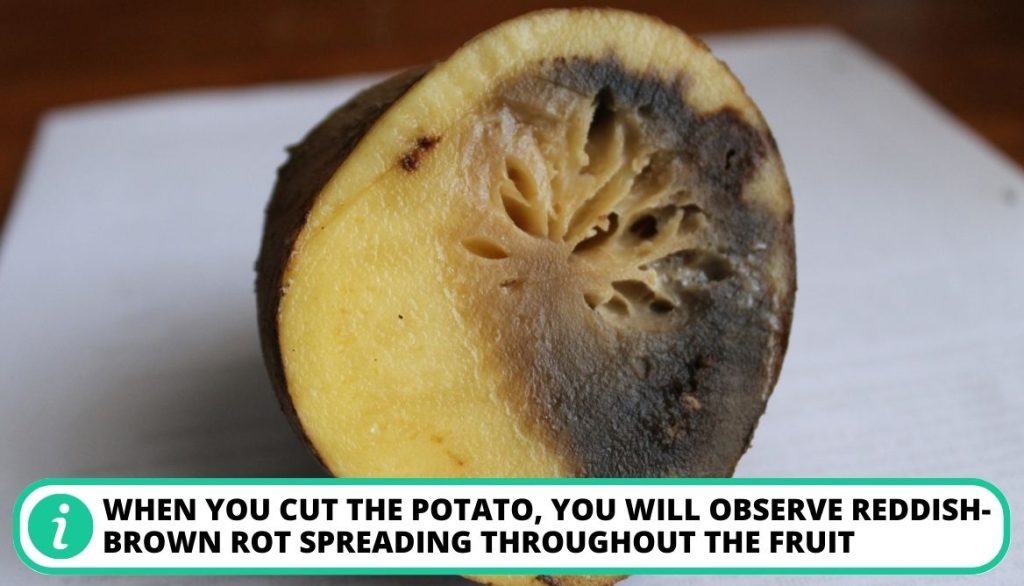
Early Blight vs Late Blight: What Set Them Apart
Here is a table that quickly differentiates between early potato blight and late potato blight strains:
Early Blight | Late Blight |
Caused by fungi (Alternaria spp.) | Caused by oomycete (Phytophthora infestans) |
Favored by warm and dry weather | Favored by moist and cool weather |
Spots have concentric rings | Spots are water-soaked |
Leaves drop from bottom to top (Affect the older leaves first) | Leaves wilt from top to bottom (Affect the younger leaves first) |
Tubers have sunken spots | Tubers have soft rot |
Now, let’s explore these types of blight in detail:
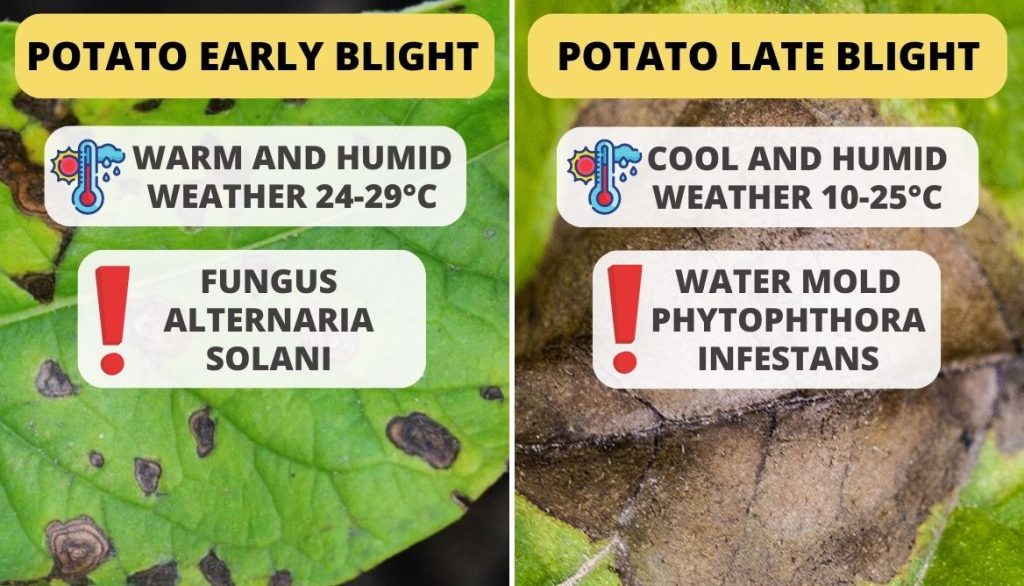
Potato Early Blight
The following are the salient features of early potato blight:
- Symptoms: It first appears as small, dark brown spots on the lower leaves of potato plants. These spots gradually enlarge and develop concentric rings, resulting in a target-like pattern. Infected leaves may also show yellowing and eventually die off.
- Causal Agent: Early blight is caused by the fungus Alternaria solani.
- Favorable Conditions: Warm and humid weather conditions, typically around 24-29°C, promote the development of early blight.
- Spread: The disease spreads through wind-dispersed potato blight spores and can overwinter in infected plant debris or potato tubers.
Potato Late Blight
Late blight is a more serious and destructive disease. You can spot the condition with these characteristics:
- Symptoms: It presents as larger, irregularly shaped dark lesions on the leaves, often with a fuzzy appearance. The lesions may also have a water-soaked appearance.
- Causal Agent: Late blight is caused by the water mold Phytophthora infestans.
- Favorable Conditions: Cool temperatures around 10-25°C and high humidity or rainfall create ideal conditions for late blight development.
- Spread: Spores are carried by wind and rain, spreading the disease rapidly within and between fields. Infected plant material or seed potatoes can also introduce late blight.
Symptoms of Potato Blight: 6 Important Things To Know
Here are some tips that can help you in pointing out blight disease:
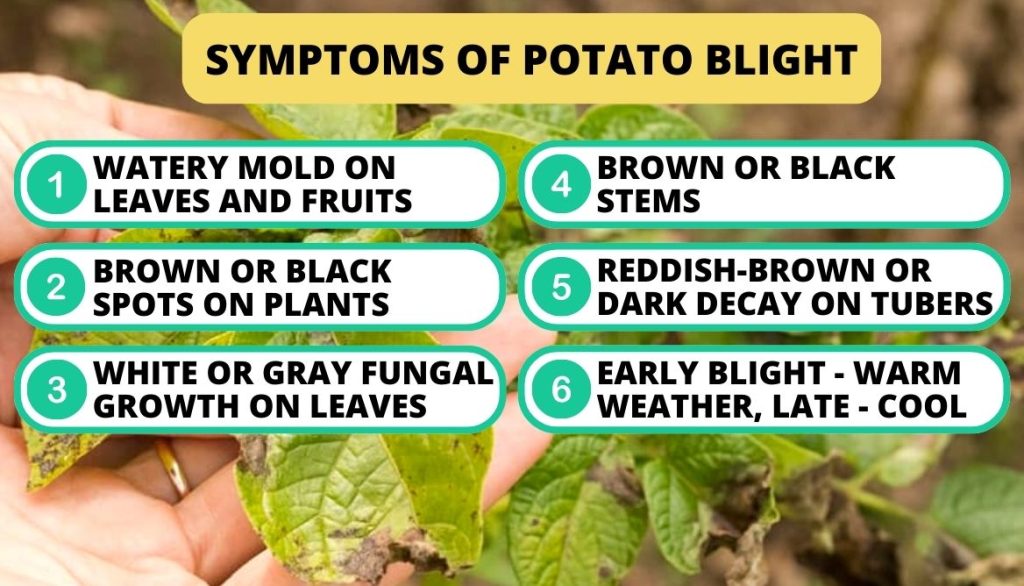
- Initial Symptoms: Early symptoms include the watery mold that rapidly spreads across the leaves and fruits.
- On the plant: Look for brown or black spots on your potato plant. These spots may have yellow halos or concentric rings around them, and they may grow larger into lesions.
- Leaves: Check the underside of the leaves for white or grayish fungal growth. This is where the blight spores are produced and released into the air or water. Observe the wilting and dropping of the leaves, especially from the lower part of the plant.
- Stems: The stems may also collapse and turn brown or black.
- On the tubers: Untreated disease may reach the tubers. Examine these parts for signs of rotting. They may have a reddish-brown or dark decay under the skin.
- Time of appearance: Note the timing and weather conditions when blight occurs. Early blight is more common in warm and dry weather. On the other hand, late blight is more common in cool weather.
Now, let’s head towards our next section and learn about saving your crop.
How to Prevent Potato Blight? 7 Handy Tips
Potato blight is an air-borne disease; therefore, its complete protection is almost impossible. However, by taking the following steps, you can prevent the rapid spread of the disease:
1. Select the Perfect Spot
Plant your potatoes in a sunny and well-drained spot with good air circulation. Avoid planting them near other plants that can host blight. Moreover, ensure a crop rotation every year to avoid soil-borne infections.
2. Use of Proper Watering Techniques
Water your potatoes in the morning so the leaves have time to dry before nightfall. Avoid overhead watering, as this can spread blight spores. Also, use drip irrigation or a soaker hose instead.
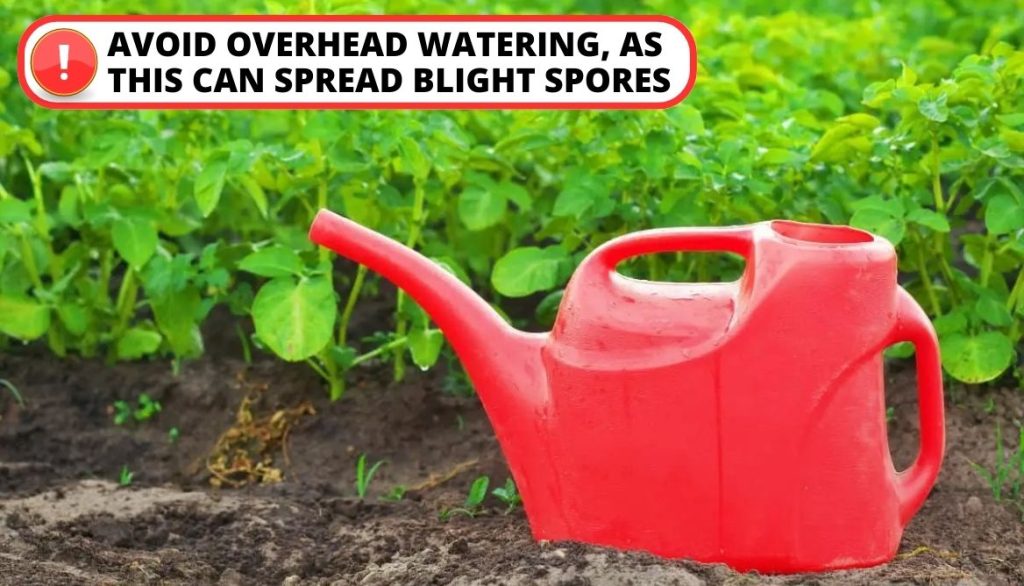
3. When to Plant Potatoes
Plant your potatoes early in the season, as soon as the soil is workable. This way, you can harvest them before blight strikes in late summer.
4. How Earthing Up Safeguards Potatoes
Earthing up means covering the base of the stems and the tubers with fresh soil first.
- This technique helps protect the plants from sunscald and blight spores that may splash from the ground.
- Additionally, earth up your potatoes regularly as they grow, especially after heavy rain helps in keeping them safe.
5. Selecting Blight-Resistant Potato Varieties
Some potato varieties are more resistant to blight than others. Look for early potatoes cultivars that have been bred for blight resistance, such as Sarpo Mira, Sarpo Axona, or Coquine.
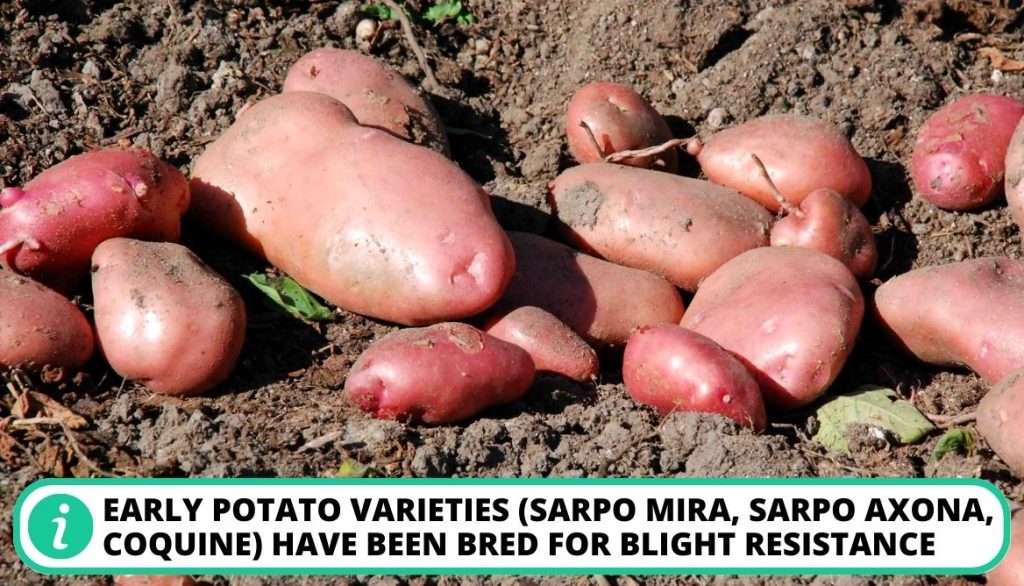
6. Apply Fungicide
If you live in an area where blight is common, apply a fungicide spray to your potato crop before the disease appears. You can use a copper fungicide, such as Bordeaux mixture, or a bio-fungicide, such as Serenade.
7. Harvest the Potatoes on Time
Ensure potato harvest as soon as they are ready, and do not leave them in the ground for too long. If you notice any signs of blight on the foliage, cut it off and dispose of it.
Wait for 2 weeks before digging up the tubers to allow any spores to die off. Store your potatoes in a dark and dry place, and check them regularly for any signs of rotting.
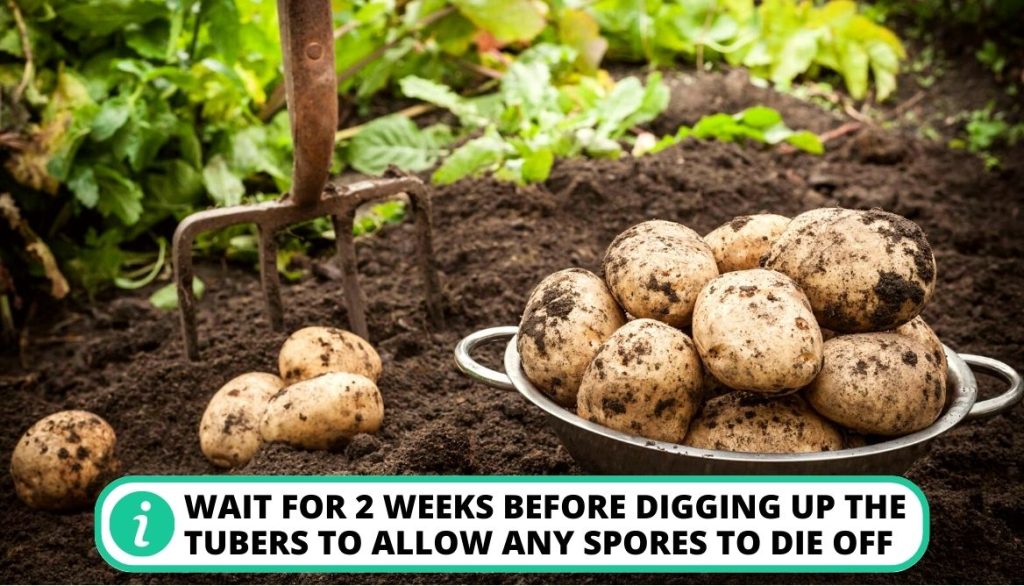
How to Treat Infected Blight Potatoes?
If you notice any signs of potato blight on your plants, it is time to act quickly to stop potato blight and save your crop. These are some steps that can help you in treating potato blight:
Managing Potato Blight on Leaves
If the disease is infecting the leaves, do the following things:
- Cut off and destroy the affected leaflets if you see any dark spots or white fungus on them.
- Do not use them as natural fertilizers as they can spread the spores.
- Leave the soil undisturbed for two to three weeks.
- You can also spray the remaining plants with a fungicide to protect them from further infection. We have shared more details in the above fungicide section.
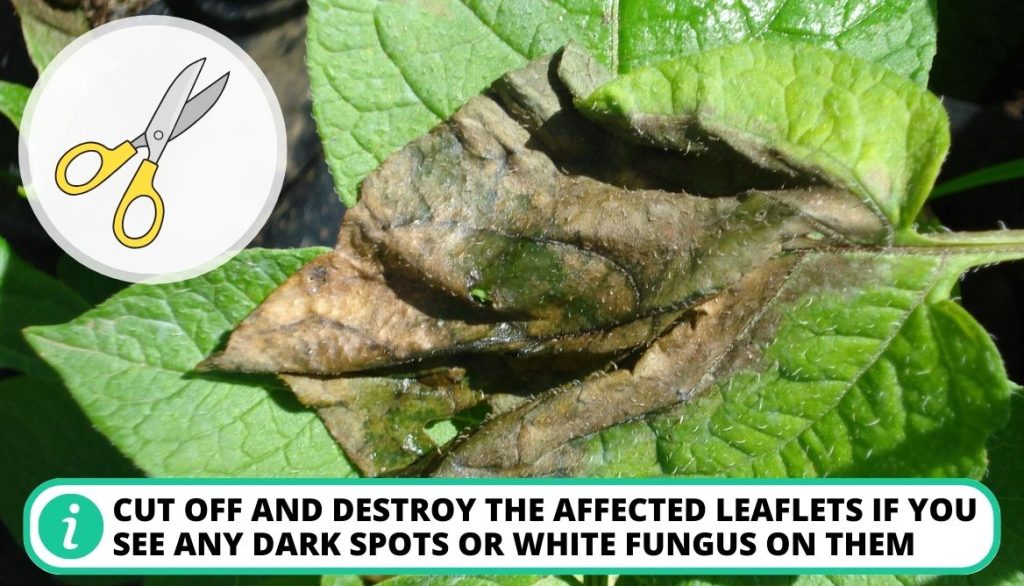
Handling Infected Potatoes
If you see the disease is on the fruits, you can do the following things:
- In the case of infected tubers, harvesting them promptly is essential to prevent further rot.
- Remember to handle infected tubers carefully to avoid spreading spores to healthy potatoes.
- Discard any tubers with reddish-brown or dark decay under the skin.
- Store the remaining healthy fruits in a dry place.
- You can also put them in a bleach/water (1:10) solution for at least 30 minutes before storing them.
FAQ
Can I eat potatoes with blight?
It is not recommended. But you can eat potatoes if you remove the blight-affected part.
Can potato blight be cured?
There is no proper cure once the potato crop has been infected. You can get rid of the damaged part. The best option is Prevention. It is the only way to keep the disease at bay at first. You can also use fungicides for this purpose.
What does early potato blight look like?
Early potato blight appears as small, dark brown spots on the lower leaves with target-like rings.
How do you identify blight?
Dark, water-soaked lesions on leaves can be identified as blight, stems, and tubers, along with white fungal growth.
Conclusion
Summing up, Blight is a fungal disease of potatoes that causes brown spots, wilting, and rotting of the leaves, stems, and tubers. It can spread quickly and wipe out your entire harvest.
To avoid this, you must follow some preventive tips, such as choosing plant blight-resistant varieties, planting in well-drained soil, removing any infected potato plants, and applying fungicides. By doing so, you can enjoy healthy and delicious potatoes for years.
How do you protect your plant from diseases? Share your methods in the comments section.
- How to Get Potatoes to Sprout Eyes: Detailed Growing Guide with 3 Options - July 31, 2023
- Weight of a Medium Potato: Revealed in Detailed Guide - July 29, 2023
- Maris Piper Potatoes: 9 Substitutes You Should Know About - July 27, 2023
Hello! I’m Jessica Zander, a garden coach and consultant based in the Boston area (zone 6b), offering virtual consultations across the country and Canada.
I’ve been passionate about gardening since the early 1990s, and in 2022, I launched You Can Do It Gardening to empower individuals to feel more confident in their gardening endeavors.
Following a 30-year career in nonprofit finance and operations, I transitioned out of that field in mid-June of 2023 due to the growing demand for coaching services. Interestingly, my years of presenting financial statements to boards and finance committees proved to be valuable experience for teaching people about gardening! I enjoy sharing skills, providing guidance and suggestions, and collaborating efficiently with clients to make significant improvements to their outdoor spaces, both small and large. I also regularly teach at the Arlington Continuing Education and Cambridge Adult Education.
My approach is direct and practical, akin to Mary Poppins, but tailored to your garden. Clients find satisfaction in saving money and taking pride in their own gardening achievements.

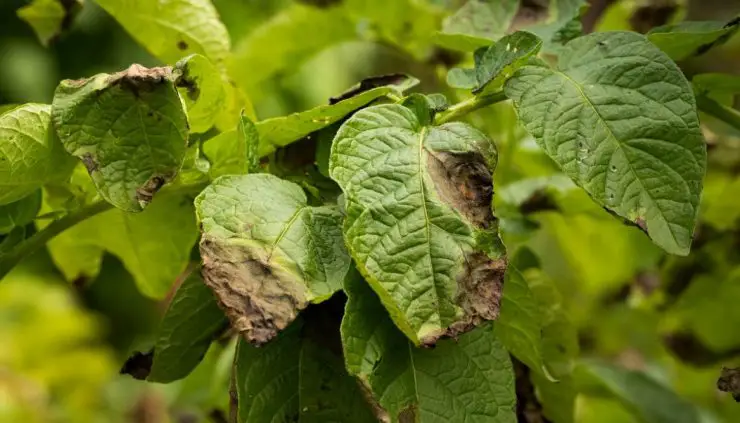
Add comment